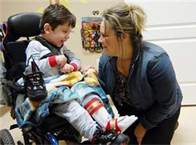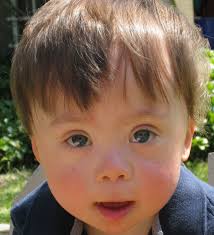Intervention Goals
Goals for the pediatric client are restoring function. For kids with neuromuscular conditions, this may mean improving head control to allow for progression in sitting activities. In the musculoskeletal population, this may mean conditioning for return to sport after joint injury or concussion. In each case, impairment-only goals do not meet the rigor required in a PT plan of care.

Many times it becomes apparent that what at one time appeared to be a relevant functional goal is no longer so, due to progressive development, changes in condition, or changes to family priorities. When this occurs, the goal should be revised to make it more applicable by the physical therapist. The PTA can suggest modifying goals as appropriate and give these suggestions to the PT.
Intervention planning
The intervention plan is grounded in the ICF model, aiming for optimizing activity at home, school, and community. Interventions should be based on what is appropriate for both the child and the family. Interventions should always consider the related body structure and functions. If the injury is acute in nature (flare-up in arthritis, soft tissue shortening secondary to immobilization, torticolis, or an injury/surgery that requires gait training with an assistive device), then the PT plan of care will look very different from PT from a neuromuscular developmental disability (cerebral palsy, traumatic brain injury, Down syndrome, developmental delay).

For American children in the age range of birth to 3 years, pediatric physical therapy intervention may take place within early intervention. Services delivered in this way must be family-centered. Historically services were child-centered and mostly focused on the specific needs of the child. Family-centered service broadens the scope of the interventions and focuses therapy on the family and the child's position in the family. Therapists assume more of a coaching role, working with the child through the family.
Intervention should also be embedded in routines that already occur in the home or within the child's day. Thus lots of time and energy will be focused on teaching the family members how to handle, position, and interact with the child to get optimal performance from the child over the span of the day. Therapy goals are worked on throughout the entire day, not just at therapy-designated time. If a child needs to increase strength, then appropriate activities will be designed so that the child works on strength while participating in his or her regularly scheduled activities. Leg strength can be improved with squat-to-stand activities. If a container/toy is placed on a low table surface, and all of the pieces are on the floor, the child must repeatedly perform squat-to-stand activities to put all the pieces into the container. Likewise, if therapy is focusing on improved fine motor skills, pulling diaper wipes from a container will work on grasp-and-release movements. These are activities embedded in typically occurring routines. If the child needs to improve a gait pattern, the parent will be taught stretching activities that can occur at every diaper change, for instance. Ambulation can be built into going to check for mail at the box or cruising around the bedroom or kitchen. A child will be more inclined to cruise if furniture is placed close together to provide ready support.
As the child enters school age, the focus of therapy may switch from a family-centered to an education-centered approach. Therapies delivered within an educational environment must focus on improving school performance. Therapy services outside the educational system may continue to be more child/family centered. For example, a 6-year-old child with diplegic cerebral palsy attends school. The child lives on the second floor of a two-story walkup building. There are no elevators in this building. The child has difficulty ambulating up the many steep steps to his apartment. His school is in a single-story building without steps. If the family wanted this child to improve his safety on the steps at the apartment, providing practice opportunities would be outside the mandates of the school therapist, since there are no steps in the school building. Thus the goal is not educationally relevant. However, the astute therapist will think about the child's participation in school activities outside of the building, such as ascending and descending the school bus steps or the playground equipment. In this way therapy could focus on stair climbing, which is important to the child's ability to be independent and safe both at home and within his educational environment. Additionally, the family may choose to engage the services of a community-based therapist to work on non education-based goals.
After the therapist, family, and child, if appropriate, have developed goals, the therapist should decide what intervention technique(s) may be most efficient and effective at helping the child meet the goals. There are several types of interventions and differing philosophies. In this chapter several of the interventions will be discussed. By no means is this an all-inclusive list or a ranking of the "best" interventions.
Intervention types
Common interventions include the following:
- Neurodevelopmental treatment (Bobath)
- Proprioceptive neuromuscular facilitation (Kabat, Knott, Voss)
- Conductive education (Peto)
- Strengthening and stability
- Therapeutic taping
- Sensory integration (Ayers)
The basis for all treatments must embrace in some form the dynamic systems model of motor control and motor learning. This model explains that all components of a child's world must be considered and will be influenced by all systems working in concert or conflict with each other. Fay Horak wrote that humans accomplish tasks using interacting systems that work together in an integrated fashion with shifting dominance . There are several physiologic systems, as well as environmental and cultural systems, to consider before determining the optimal intervention. If any component of any of these systems is not on target and not working in concert with the other systems, dysfunction will occur. It is up to the treating therapist to collect all the clues and decipher which component is not up to par, then determine if intervention focus should correct the malfunctioning component or assist the child and family to adapt and learn new strategies in order to function as independently and optimally as possible.
Comparison of Common Interventions
|
INTERVENTION |
PHILOSOPHY |
APPROPRIATE USE |
|
Neurodevelopmental treatment (NDT) |
Uses motor control to effect postural control and interactions between many neurologic and physiologic systems. Enhances the individual's capacity to function.
|
Children with cerebral palsy and motor disorders |
|
Proprioceptive neuromuscular facilitation (PNF) |
Strengthens muscle groups within diagonal and rotational movement patterns, based on developmental sequence and the sequential mastery of motor milestones.
|
Children with muscle imbalances |
|
Conductive education (CE) |
Views child as a whole child, using learning concepts, motor control/motor learning, and the group model to improve function. Learning movements and functional skills requires practice, intention, group motivation, and breaking down skills into task series. Uses specialized equipment to enhance child's orthofunction (ability to be functional and independent).
|
Children with C P, spina bifida, and other motor disorders |
|
Strengthening balance, gait and stability |
Improved function through improved strength, bone density, joint structures, muscle function, and management of obesity.
|
Children and infants with weakness and muscle imbalances which include but is not limited to Down's Syndrome, Duchenne's Muscular Dystrophy, Cerebral Palsy, Spina Bifida and developmental delays due to pre-term deliveries in some cases. |
|
Therapeutic taping |
Uses rigid or flexible taping to support and influence muscle groups. |
Children with muscle weakness, joint instability, joint malalignment, and postural asymmetries
|
|
Sensory integration (SI) |
Provides controlled sensory input to help children with sensory processing. |
Children with sensory processing dysfunction; children exhibiting dysfunction in ability to take in and process sensory information, organize behaviors and movements, or formulate/plan/and execute motor plans.
|
In addition to the physiologic systems, each child is influenced by environmental and cultural systems. Environmental systems include the child's primary living habitat, school or day care facility, neighborhood, and resources to function in these environments. Cultural systems include the family's traditions and beliefs, the extended families' traditions and beliefs (which may differ somewhat from the immediate family's), and known or perceived expectations of the child from society at large.
In order for an intervention plan to be successful, all the described systems that have an effect on a child must be continually assessed and monitored. Although a child may have a primary pathology or functional limitation, various influences from other systems may negatively affect the child and impact the primary impairment.

